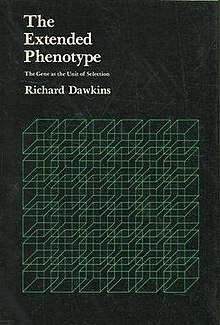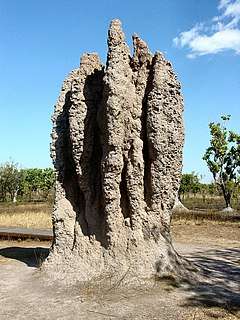The Extended Phenotype
The Extended Phenotype is a 1982 book by the evolutionary biologist Richard Dawkins, in which the author introduced a biological concept of the same name. The main idea is that phenotype should not be limited to biological processes such as protein biosynthesis or tissue growth, but extended to include all effects that a gene has on its environment, inside or outside the body of the individual organism.
 Cover of the first edition | |
| Author | Richard Dawkins |
|---|---|
| Country | United Kingdom |
| Language | English |
| Subject | Evolutionary biology |
| Publisher | Oxford University Press |
Publication date | 1982 |
| Media type | |
| Pages | 307 pp. |
| ISBN | 0-19-286088-7 |
| OCLC | 19921696 |
| 575 20 | |
| LC Class | QH375 .D38 1983 |
| Preceded by | The Selfish Gene |
| Followed by | The Blind Watchmaker |
Dawkins considers The Extended Phenotype to be a sequel to The Selfish Gene (1976) aimed at professional biologists,[1] and as his principal contribution to evolutionary theory.[2]
Summary
Genes synthesize only proteins

Dawkins argues that the only thing that genes control directly is the synthesis of proteins. He points to the arbitrariness of restricting the idea of the phenotype to apply only to the phenotypic expression of an organism's genes in its own body. Dawkins develops this idea by pointing to the effect that a gene may have on an organism's environment through that organism's behaviour.
Genes may affect more than the organism's body
Dawkins suggests that there are three forms of extended phenotype. The first is the capacity of animals to modify their environment using architectural constructions. Dawkins cited as examples caddis houses and beaver dams. The second is manipulating other organisms. Dawkins points out that animal morphology, and ultimately animal behaviour, may be advantageous not to the animal itself but, for instance, to a parasite which afflicts it – "parasite manipulation". This refers to the capacity, found in several groups of parasites, to modify the behaviour of the host to increase the parasite's own fitness. One famous example of this second type of extended phenotype is the suicidal drowning of crickets infected by hairworm, a behaviour that is essential to the parasite's reproductive cycle. Another example of such behaviour is seen in female mosquitoes carrying malaria parasites. The mosquitoes are significantly more attracted to human breath and odours than uninfected mosquitoes.[3] A 2013 study shows that an immune challenge with heat-killed Escherichia coli can generate the same changes in the behaviour as is seen in infection by Plasmodium yoelii. It raises an unanswered question: to what extent is the alteration of host behaviour due to active manipulation selected for in malaria parasites?[4]
The third form of extended phenotype is action at a distance of the parasite on its host. A common example is the manipulation of host behaviour by cuckoo chicks, which elicit intensive feeding by the parasitized host birds. These behavioural modifications are not physically associated with the host but influence the expression of its behavioural phenotype.[5]
Dawkins summarizes these ideas in what he terms the Central Theorem of the Extended Phenotype:
An animal's behaviour tends to maximize the survival of the genes "for" that behaviour, whether or not those genes happen to be in the body of the particular animal performing it.[2]

Gene-centred view of life
In conducting this argument, Dawkins aims to strengthen the case for a gene-centric view of life, to the point where it is recognized that the organism itself needs to be explained. This is the challenge which he takes up in the final chapter entitled "Rediscovering the Organism." The concept of extended phenotype has been generalized in an organism-centered view of evolution with the concept of niche construction,[6] in the case where natural selection pressures can be modified by the organisms during the evolutionary process.[7]
Limitations
Subsequent proponents expand this theory and posit that many organisms within an ecosystem can alter the selective pressures on all of them by modifying their environment in various ways.[8] Dawkins himself asserted, “Extended phenotypes are worthy of the name only if they are candidate adaptations for the benefit of alleles responsible for variations in them”.[9] For example, in humans, an architect's specific alleles are neither more nor less likely to be selected based on the design of his or her latest building.
References
- Richard Dawkins, An Appetite for Wonder: The Making of a Scientist, Black Swan, 2013, page 291.
- Dawkins, Richard (1989). The Extended Phenotype. Oxford: Oxford University Press. p. xiii. ISBN 0-19-288051-9.
- https://www.newscientist.com/article/dn23543-malaria-bug-may-give-mosquitoes-a-super-sense-of-smell.html
- Cator, LJ; George, J; Blanford, S; Murdock, CC; Baker, TC; Read, AF; Thomas, MB (2013). "'Manipulation' without the parasite: altered feeding behaviour of mosquitoes is not dependent on infection with malaria parasites". Proc. Biol. Sci. 280 (1763): 20130711. doi:10.1098/rspb.2013.0711. PMC 3774228. PMID 23698008.
- D. P. HUGHES, J. BRODEUR and F. THOMAS (2012) Host Manipulation by Parasites. Oxford.
- Odling Smee, John; Laland, Kevin; Feldman, Marcus (2003). Niche Construction: The Neglected Process in Evolution. Princeton: Princeton University Press.
- Pocheville, Arnaud (2010). "What Niche Construction is (not).". La Niche Ecologique: Concepts, Modèles, Applications. Paris: Ecole Normale Supérieure. pp. 39–124.
- Hunter, Philip (March 2009). "Extended phenotype redux. How far can the reach of genes extend in manipulating the environment of an organism?". EMBO Reports. 10 (3): 212–5. doi:10.1038/embor.2009.18. PMC 2658563. PMID 19255576.
- Dawkins, Richard (2004). "Extended Phenotype – But Not Too Extended". Biology and Philosophy (19): 377–396. CiteSeerX 10.1.1.737.1422. doi:10.1023/B:BIPH.0000036180.14904.96.
External links
- The Tactless Meme - by Jon Seger, New Scientist
- Book profile - from The World of Richard Dawkins